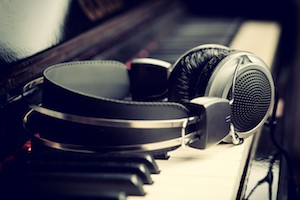
Did you know that studio headphones can represent one of the most powerful tools you can have for home recording?
I know this sort of flies in the face of the traditional recording advice, which says that listening to audio through loudspeakers – so that the audio comes through the air – is the best way to mix. In fact some of the old wisdom says “never mix with headphones.” And if we all had perfect acoustic listening spaces, that would be decent advice.
But in home studios, we almost NEVER have ideal acoustical spaces in which to listen to our recorded audio so that it sounds accurate to our ears when we listen through monitor speakers. So headphones offer us a way to sort of offset the negative distortions that a poor listening room can have on our recordings.
Of course, headphones can distort the audio in their own way. So if you approach your final audio edits and mixes with this in mind – and also listen to test mixes in other environments (in the car, on the home stereo, etc.), you can be much closer to an accurate and “portable” (will sound good played on any system) final product.
One other way in which headphones can provide us with superior audio is when editing voiceover recordings. Music can easily mask little noises and imperfections in vocal recordings, such as p-pops, mouth noises, and background sounds like hiss, computer hum, etc. And even without music to hide these things, it can still be quite difficult to hear them with just speakers. Headphones brings these things front-and-center, allowing you to clean up your vocal nicely.
Here’s what Graham has to say about this in an article by The Recording Revolution.
777
Home Recording Equipment
Reverb And Compression
In this article by Audio Fanzine, we’ll see how to make reverb and compression work together. At first it might seem weird to want to compress a reverb. And yet a compressor placed before or after the reverb can prove quite useful for controlling the reverberated signal. Here’s the link to the article.
Getting Your Mix Radio Ready
When you’re nearly finished with your mix, you need to ask yourself a very important question which is, “Is your mix radio ready?”
Here’s a video tutorial by The Recording Revolution which shows us 2 mastering moves for radio ready mixes.
Double Tracking Guitars on REAPER
Here’s a video tutorial from The Reaper Blog about recording doubled guitars on Reaper. Check out the video here. It’s the best way I know of to get a huge guitar sound – even better than recording a single guitar with a stereo mic (or pair of mics).
to summarize the process, simply record your guitar on one track. Then record the SAME part again, on a second track. Once that is done, just pan one of the tracks to the left and the other track to the right. The resulting sound will be a really cool stereo acoustic guitar sound. Try it. You’ll love it:).
Talking About The Parallel Mix Trick
Good news! Now according to the Recording Revolution, there’s a way to get more energy, fatness, and power in your mixes without killing your dynamics or transients. Want to know more? Click here.